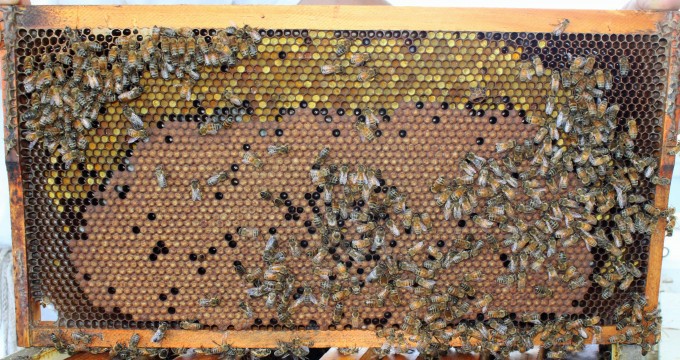Today I looked into the nuc-in-a-box to see if the queen was finally laying. I took out a frame at the edge and saw activity on the floor of the hive. It looked like a queen surrounded by her court, except the queen was not moving. I tried to extract her as the bees continued to surround and climb atop the queen.
After some time, I was able to retrieve the queen's carcass. She is currently in a jar in the freezer.
There are a few possible explanations. The bees killed this queen by
balling because they did not like her or that there was another queen they liked better. Or, the queen died for some other reason and they were all around her because of her pheromones and were trying to carry her out of the hive. (I did see them dragging her towards the entrance.) Or there is another queen in the hive that killed her. In any case, I looked through the rest of the frames and saw no sign of laying.
 |
| Empty and polished cells awaiting eggs |
In any case, I will wait to see what happens. We can hope that there is another queen who will successfully mate. I will check again in 2 weeks.
Then I took a look in the nuc I had made by splitting from #1 a couple of weeks ago. I had put the queen from #1 in the nuc and left eggs and young larvae behind so a new queen could be made. (In another week or so I will look to see if there is a laying queen.) There was a lot of brood, eggs and larvae in the nuc. I impetuously decided to put these bees into #2.
This expert does not recommend doing this to save a laying worker colony.
This one says it can work; as a matter of fact, I sort of did it a way she suggests.
When combining hives, one is supposed to put the weaker hive on top of the stronger hive, leaving the stronger hive in its locale. This would not work for me; I want the hive over with the others. So this is what I did.
I covered the entrance of the nuc and took it over to the apiary. I took all the boxes of #2 off the bottom board. There were not many bees left in #2. The bottom box had drawn comb with empty cell, most bees and drone brood were in the top brood box and the super was very light. Then I thought. If I put the nuc frames (the strong hive) on the bottom, the returning foragers would fight with the nuc bees, so I put the top box of the weak hive (#2) on the bottom. I shook the few bees that were on the empty comb from the bottom into the hive and then put a double screen board (that I had made) on top. I then took the frames from the once bottom box and cleaned the box by scraping off as much propolis and wax as I could. I put the empty box on top of the double screen board with the entrance in the back relative to the other entrance. Into the box I put the 5 frames from the nuc as well as 5 frames of drawn comb. On top went the honey super and I closed it up.
Meanwhile, back at the ranch... returning foragers wondered where their home had gone.
 |
| The bees are looking for their former home which had been on the pots |
Later I did see a couple of bees go out the back entrance. So, we will have to wait three weeks or so to see if this works. Of course, if all the remaining bees of #2 die, I will remove the double screen board and reverse the boxes. It's almost like I know what I'm doing.
It was pointed out to me that the hive stand holding #1 & 2 likely would not be able to hold the expected 150 pounds of honey, so I made braces. Tomorrow I will put angle braces on to keep them in place. I think this winter I will build new hive stands, either of metal pipe or 2x4s.







































